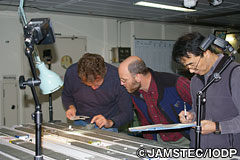
Weekly report #5
2007.12.19
IODP NanTroSEIZE Stage 1:
Expedition 315: NanTroSEIZE "Megasplay Riser Pilot"
Weekly Report #5 (Final report)
Date 19/Dec/2007
Drilled and cored from 976.5 meter below seafloor (mbsf), and cut 8 RCB cores in Hole C0002B. Stuck around 1029 mbsf at 16:50 p.m. and 1715 p.m. Came free with 300 kN over pull and worked pipe with pumping 10m3 hi-vis drilling fluid each time. After cutting 66R core, encountered hole problem below 1057 mbsf. Despite repeated reaming, hole condition did not improved. Abandoned the hole and pull out of hole.
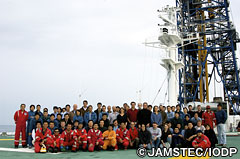
Expedition 315 Shipboard members include marine crew,
drilling engineers, lab technicians and scientists.
>>Expedition 315 Photo Gallery
Moved the Chikyu 6 miles upstream and made up 11-7/16" HPCS coring assembly. Run in hole the assembly to 1965 m water depth, and performed two surface HPCS cores on Hole C0002C. Moved the Chikyu 10m to next location of C0002D and perform HPCS coring. Cored to 204 mbsf and cut 18 cores (16 HPCS and 2 ESCS). Attempted downhole temperature measurement on every second cores and obtained temperature profile to 159 mbsf.
Half of the Science Party of Expedition 315 disembarked on 13 Dec and half of the next Expedition 316 Science Party came onboard instead. Cross-over between two Science Parties was being proceeded through processing of cores from the Hole C0002B, C and D. Cores from the Hole D are dedicated mainly to geoengineering assessments for riser BOP deployment. As well as sampling of whole-rounds and shear strength measurements, non-destructive core measurements were carried out as usual. Temperature measurements by APCT3 were successfully conducted down to 159 mbsf in the Hole C0002D.
Four lithostratigraphic units were defined (Unit I–III for Kumano Basin sediments, Unit IV for accretionary prism). Clear differences were observed between Unit IV and other units in terms of structure, chemistry, physical properties, etc.
Since C0002 was a contingency site, and there was no specific sample request, only time critical whole-round sampling, non-destructive measurements and description on split surface were done for cores from Hole C0002B. Cores from Hole C0002D were basically dedicated to geoengineering purpose, therefore, only non-destructive WR measurements and WR sampling for IW, microbiology and geotechnical tests were carried out.
On Dec 18, retrieved transponders by ROV and finished all operations for expedition 315. The Chikyu left the location to the next drilling site by the midnight.
The weekly report about the Expedition 315 was reported by the Co-Chief Scientists (Dr. Siegfried Lallemant and Dr. Juichiro Ashi), CDEX Operations Superintendent (Mr. Ikuo Sawada and Tsuyoshi Abe) and CDEX Expedition Project Manager (Dr. Hideki Masago).

Weekly report #4
2007.12.14
IODP NanTroSEIZE Stage 1:
Expedition 315: NanTroSEIZE "Megasplay Riser Pilot"
Weekly Report #4
Date 14/Dec/2007
Having left the Site C0001, moved to the new location Site C0002. After deployment of transponders, spud in the Hole C0002B in the morning of 9 Dec. Jetted down to 50 meters below seafloor (mbsf), then started drilling by RCB assembly with center bit. After drilling to 475 mbsf, started coring. Drilled and cored to 1057 mbsf and cut more than 50 cores. Cores are routinely described, measured and sampled by Science Party. Some non-routine measurements for the discrete samples taken from the Hole C0001H cores were also carried out.
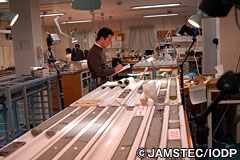
Shipboard scientist works day and night by rotation.
Dr. Hiroki Hayashi (JPN) carry on visual core description.
>>Expedition 315 Photo Gallery
At the Hole C0002B, we reached to the base of the Kumano forearc Basin around 920 mbsf, and penetrated into the accretionary prism. The accretionary prism rocks are characterized by scaly fabric and systematic fractures, which has highly different looking from the basin sediments above.
Site Summary Meeting for Site C0001 was held on 8 Dec. End-of-Expedition Meeting was held on 11 Dec. Half of the Science Party left the ship on 13 Dec, and half of the next (Exp 316) Science Party came onboard. They were incorporated into the current work shifts immediately, and cross-over between two Science Parties is going on.

Weekly report #3
2007.12.7
IODP NanTroSEIZE Stage 1:
Expedition 315: NanTroSEIZE "Megasplay Riser Pilot"
Weekly Report #3
Date 07/Dec/2007
Restarted RCB coring in Hole C0001H on 30 Nov. After taking two cores (25R and 26R), stopped coring at 456.2 mbsf due to bad hole condition. Pull-out-of-hole the RCB assembly, and started make-up of 10-5/8" drilling assembly. ROV retrieving required another wait on weather for sea current. Retrieved ROV and started run-in-hole on 1 Dec. Run-in-hole 10-5/8" drilling assembly and re-entered the Hole C0001H. Washed and reamed down to 458.3 mbsf, then drilled down to 600 mbsf for two days. Pulling-out-of-hole drilling assembly in the morning of 4 Dec, moved 6 miles upstream of the current and started run-in-hole of RCB assembly. Ship on location in the evening, re-entered the Hole C0001H and continued run-in-hole to 275 mbsf. Having high weight on bit, washed and reamed from 268 to 345 mbsf. Despite of repeated washing and reaming, borehole condition of the Hole C0001H did not improved. Abandoned the hole and pulled-out-of-hole the coring assembly to the seafloor. Moved 60 meastward and spud a new hole (Hole C0001I) at 1550hr, 5 Dec. Jetted in down to 70 mbsf, then drilled down to 433 mbsf with RCB assembly with center bit. Continued drilling from 433 mbsf with RCB assembly with center bit at the Hole C0001I. Having several times small stuck (high torque), repeated washing and reaming down to 522 mbsf. While reaming 433 to 467 mbsf, had pipe stuck at 467 mbsf, which required 700 kN for freeing pipe.After escaping from this zone, we gave up further drilling and coring, and started pull-out-of-hole in the morning of 7 Dec.
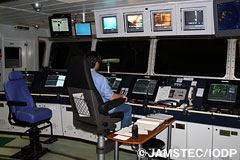
The helmsman maintains the Chikyu’s position with the Dynamic Positioning System (DPS).
>>Expedition 315 Photo Gallery
Drilled and cored 10.6 m in Hole C0001H. Total 2 cores were taken and routinely described, measured and sampled by Science Party. Routine measurements (see Lab Activity below) have completed for all cores including Hole C0001B cores taken in the Exp 314.
Bio- and paleomagnetic stratigraphies are providing good inter-hole correlation between C0001E and F. Also, core–log integration is successfully ongoing with corrected P-wave velocity and electric resistivity data obtained by discrete sample measurements.
Personal sampling from the working halves were proceeded in parallel with routine measurements . MSCL-W NGR, XRD, UV-Vis were fixed, and these postponed analyses have also been completed. Other routine measurement subjects are listed below.
- Whole-round (WR) sampling for interstitial water at Core Cutting Area
- CT-scan
- WR sampling for microbiology
- MSCL and thermal conductivity for WR core (no thermal conductivity for RCB cores)
- WR sampling for other purposes (geotechnical, structural)
- Visual description
- Image scanning
- Colorimetry
- Magnetic property
- Moisture and density
- Shear strength (Vane shear / penetrometer)
- Microfossil age determination (nanno, foraminifer)
- Sampling for element analyses (total / inorganic C, N, S)
- P-wave velocity and electric conductivity for discrete cubes
In addition to the above-listed routine measurements,element analyses (C, N, S), inorganic carbon analysis, cation analyses for interstitial water were carried out.

Weekly report #2
2007.11.30
IODP NanTroSEIZE Stage 1:
Expedition 315: NanTroSEIZE "Megasplay Riser Pilot"
Weekly Report #2
Date 30/Nov/2007
Continued coring at the Hole C0001F. After taking 2 cores by HPCS, changed to ESCS and cored 19.0 m and took 2 cores (20X and 21X). Because of bad core quality, quitted ESCS coring and abandoned the hole. Spud a new hole (C0001G) for RCB coring on 25 Nov, jetted down to 74.5 meters below the seafloor or mbsf, and started drilling. Just after drilling, ROV umbilical cable jammed to the drill pipe. Pulled-out-of-hole and recovered ROV safely. Spud a new RCB hole (Hole H), 10 m west to the previous hole, jetted down to 74 mbsf and restarted drilling on 26 Nov. Started RCB coring from 230.0 mbsf and took 24 cores until 28 Nov. Concerning expected bad weather stopped coring at 448.0 mbsf and set free fall funnel before wait-on-weather on 29 Nov.
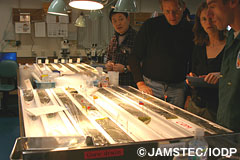
Shipboard scientists observe the core at Lab. Drs. Toshiya Kanamatsu (JPN),
Jan M. Behrmann (DEU), Babette Boeckel (DEU) and Pierre Henry (FRA)
(left to right)
>>Expedition 315 Photo Gallery
Drilled and cored 28.5 m in Hole C0001F, and 438.5 m in Hole C0001H, respectively. Total 28 cores (2 HPCS, 2 ESCS and 24 RCB) were taken and routinely described, measured and sampled by Science Party. Routine measurement subjects are:
- Whole-round (WR) sampling for interstitial water at Core Cutting Area
- CT-scan
- WR sampling for microbiology
- MSCL and thermal conductivity for WR core (no thermal conductivity for RCB cores)
- WR sampling for other purposes (geotechnical, structural)
- Visual description
- Image scanning
- Colorimetry
- Magnetic property
- Moisture and density
- Shear strength (Vane shear / penetrometer)
- XRD
- Microfossil age determination (nanno, foraminifer)
- Sampling for element analyses (total / inorganic C, N, S)
- P-wave velocity and electric conductivity for discrete cubes (for RCB cores)
In addition to the routine measurement described above, non-routine chemical analyses (ICP-AES, XRF-CL) have started. Two ESCS cores had relatively good recovery, however also had terrible drilling disturbance. RCB cores taken from the overlapping intervals to ESCS ones showed better qualities. Started systematic personal sampling from split haves, which was originally planned during riser hole casing operation. After the core liner burst last week, all personnel working on core cutting operation wear face shield in addition to normal Personal Protective Equipment.

Weekly report #1
2007.11.23
IODP NanTroSEIZE Stage 1:
Expedition 315: NanTroSEIZE "Megasplay Riser Pilot"
Weekly Report #1
Date 23/Nov/2007
Expedition 315 started on 16 November. After one day maintenance for drilling equipments, pre-spud meeting was held on 18th and description and routine measurements were done for Hole B cores (taken in the Expedition 314).Started RIH in the evening of November 19th.
Observed HPCS core barrel was broken during running with core line at 1515 m water depth, due to strong vibration caused by Kuroshio current. Fishing operation succeeded in the early morning of 20th, restarted running again to the seafloor and spud-in the Hole E.
13 cores were taken by HPCS until morning of 21st. Downhole temperature measurement was carried out by APCT3 for every third core from the Core 2H. After shooting the 14th core, inner barrel parted at bottom of 2nd rod connection. Abandoned the Hole E, moved 20 m east and spud-in the Hole F. Wash down to 108 meters below the seafloor (mbsf) and started coring with about 10 m of overlap with the previous hole. Core liner busted in the Core Cutting Area on Hole F Core 10H probably due to high gassy sediments. Co-chiefs, EPM, Lab Officer and OSI discussed about safer procedures: 1) punctuation on a liner in advance to coring, 2) cover a liner around the place to cut by half-round plastic pipe while cutting. Drilled to 220.3 mbsf and took 17 cores by HPCS. Downhole measurement with APCT3 was performed on Cores 2H, 5H and 8H.
Total 31 cores have been routinely described, measured and sampled by Science Party since 20th. Routine measurement subjects are:
Whole-round (WR) sampling for interstitial water at Core Cutting Area, CT-scan, WR sampling for microbiology, MSCL and thermal conductivity for WR core, WR sampling for other purposes (geotechnical, structural), Visual description, Image scanning, Colorimetry, Magnetic property, Moisture and density, Shear strength (Vane shear / penetrometer), XRD, Microfossil age determination (nanno, foraminifer) and Sampling for element analyses (total / inorganic C, N, S).
In the evening of 22nd, seemed to reach to the base of the slope sediments, which is the first major tectono-lithostratigraphic boundary defined by seismic profile. Downhole temperature measurement with APCT3 was carried out at total 7 depths down to 179 mbsf, and yielded good temperature gradient.














